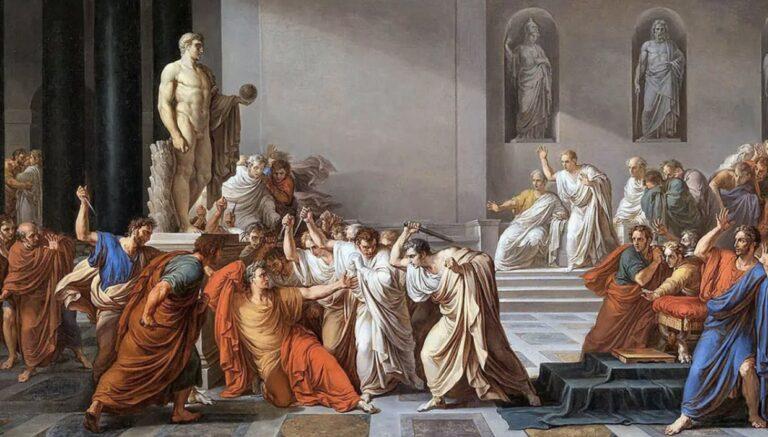735AD: Death of The Venerable Bede (b.672), English historian and theologian, whose many scholarly works include the first comprehensive history of the British Isles, titled Historia ecclesiastica gentis Anglorum (The Ecclesiastical History of the English People).
1332: Birth of Ibn Khaldun (d.1406), the great Arab polymath whose theory of business cycles and the rise and fall of nations remains foundational to any serious sociological study.
1521: Concluding the process of the Imperial Diet* that began in mid-April, Holy Roman Emperor Charles V issues the Edict of Worms, formally declaring Martin Luther a heretic and outlaw, subject to arrest and punishment. The edict reads in part: “For this reason we forbid anyone from this time forward to dare, either by words or by deeds, to receive, defend, sustain, or favor the said Martin Luther. On the contrary, we want him to be apprehended and punished as a notorious heretic, as he deserves, to be brought personally before us, or to be securely guarded until those who have captured him inform us, whereupon we will order the appropriate manner of proceeding against the said Luther. Those who will help in his capture will be rewarded generously for their good work.” Disregarding prior negotiations that promised safe passage, Luther’s friend and mentor Prince Frederick III, Elector of Saxony captured him enroute to his home and spirited him away to safe haven in Wartburg Castle, where he began work on his German translation of the Bible. The Edict was temporarily suspended in 1526 but was put back in force in 1529. Although it was never enforced against Luther himself, it was used as justification for arrests of Lutheran agitators in the Low Countries under Charles’ direct control.
1541: Death of French religious reformer John Calvin (b.1509), one of the key figures of the Protestant Reformation, whose insights and writings on Christian doctrine remain the foundation of the Presbyterian and other Reformed churches. Much of his work occurred in Geneva, where his church became a center for a group of English dissidents under John Knox, among other groups dealing with the intellectual and religious ferment of the time.
1626: Director-General of the New Netherlands division of the Dutch West Indian Company, Peter Minuit, purchases Manhattan Island from the local indigenous tribe for items valued at 60 Guilders, often mis-represented as $24 of wampum. In order to both help perpetuate tradition (the $24 story), while still propagating something resembling truth, here is a little context: records also exist of Minuit negotiating for similar ownership rights on Staten Island in trade for “duffle cloth, iron kettles and axe heads, hoes, drilling awls, Jew’s Harps and other divers items…” Historians Edwin Burrows and Mike Wallace in 1999 put this into modern terms: “…the Dutch were engaged in high-end technology transfer, handing over equipment of enormous usefulness in tasks ranging from clearing land to drilling wampum.”
1701: Death of Scottish-American privateer Captain William Kidd (b.1655), hanged by the neck until dead after his conviction in a London court for murder and piracy. His corpse is put into a gibbet on the Execution Dock, where it remains on display for thirty years (yes) as a warning to other potential pirates. Kidd’s story is the basis for many tales of buried treasure and other themes from the “golden age” of piracy. There remains to this day something of a cottage industry engaged in clearing his name by establishing his bone fides as an authorized privateer, betrayed by his sponsors in England.
1703: After capturing a Swedish fort further up the Neva River, and determined to drag sclerotic Russian leadership and society into the mainstream of the Western European world, Tsar Peter I (The Great) commissions the city of Saint Petersburg as he lays the foundation stone of the Peter and Paul Fortress on Zyachay (Hare) Island in the Neva delta. He names the new city after his patron saint, and sets in motion a development process that brings in the finest Western European architects and planners to essentially create- tabula rasa- the northernmost, and most beautiful capital city in Europe.
1738: The English colonies of Pennsylvania and Maryland sign a peace treaty, ending Cresap’s War, also known as the Conojocular War. The boundary dispute arose out of an imprecise description of Pennsylvania’s southern boundary in its 1681 charter- or more exactly, a very precise description based on incorrect geography: the start point was the town of New Castle, Delaware, and from thence “…a circle drawn at twelve miles distance from New Castle Northward and Westward unto the beginning of the fortieth degree of Northern Latitude, and then by a straight Line Westward..” The dispute reared up in 1730 when Maryland began to enforce its territorial claims after ten years of settlements and counter-settlements by Pennsylvanians in the lands west of the Susquehanna River. The flash point became dueling ferry services (no joke) established by the two colonies. In 1730 two Pennsylvanians attacked the Maryland ferry run by Thomas Cresap. No-one was injured, but Cresap began a harassment campaign against Pennsylvania settlers, eventually leading sporadic violence against both parties, and ultimately to the militias of both colonies marching across each others’ claims. King George II ordered the Royal Committee for Plantation Affairs to settle the dispute, and the agreement was signed on May 25th. The territorial definition was conclusively settled after the 1767 survey completed by Charles Mason and Jeremiah Dixon.
1787: The Constitutional Convention, under the leadership of General George Washington, convenes in Philadelphia to write a new governing document to replace the inadequate Articles of Confederation.
1819: Birth of American poet Julia Ward Howe (d.1910), who wrote the lyrics to stirring Battle Hymn of the Republic.
1856: Rabid abolitionist John Brown leads a group that murders five pro-slavery settlers in Pottawatomie, Kansas. Before the secessionist movement took root in the South, “Bleeding Kansas” became the violent first battleground between pro- and anti-slavery forces.
1883: After 14 years of highly technical and complex construction, the Brooklyn Bridge opens for traffic.
1896: In Moscow, the thirty year old Nikolay Alexandrovich Romanov is crowned Czar Nicholas II, Emperor and Autocrat of All the Russias.
1896: In New York, James Dow publishes his first index of key industrial stocks, 12 companies with an index value of 40.94.
1914: Bosnian Serb anarchist Gavrillo Princip leaves Belgrade on a conspiratorially secret 10 day journey to Sarajevo.
1921: Opening day in the trial of Sacco and Vanzetti, in Boston. The two immigrant Italian anarchists, usually described sympathetically as a shoe-maker and a fish monger, were arrested for robbery and murder, and after a internationally sensational trial were sentenced to death. The trial gained notoriety not only for the lurid twists and turns promulgated by both the prosecution and the defense (“someone changed the barrel of his gun!”), but also by the two’s unrepentant status as international anarchists. Further controversy followed as the presiding judge Webster Thayer refused to grant five motions for new trials, later confronting a colleague with, “Did you see what I did with those anarchistic bastards the other day? I guess that will hold them for a while…”Sacco and Vanzetti’s case became a cause célèbre world-wide, and even non-leftists grew increasingly uncomfortable with the court’s seeming disregard for normal evidentiary rules and appeal procedures. With the wheels of justice inexorably moving forward, Sacco and Vanzetti were electrocuted on August 23rd, 1927. To no one’s surprise, anarchist riots and bombings broke out in response as far away as Buenos Aires.
1927: In Dearborn, Michigan, last day of production of the Ford Model T, as equipment on the assembly line is changed out to produce the new Model A. The Model T was the first car to be mass-produced, beginning in 1908. With over 15,000,000 produced, it was the best-selling car in the world until surpassed by the Volkswagen Beetle in 1972. Interestingly, as part of its centenary celebrations in 2003, Ford produced six new Model Ts using long-warehoused original components and other parts made from original drawings.
1934: After a four year spree of robbery and murder, Bonnie Parker (b.1910) and Clyde Barrow (b.1909) are gunned down by a posse in rural Black Lake, Louisiana.
1937: Opening Day of the Golden Gate Bridge, linking San Francisco with my actual hometown in Marin County.
1940: Opening of the 9-day Battle of Dunkirk, where British and other Allied forces were surrounded on the French beach by the two German armies which swept across the Low Countries and burst out of the “un-passable” Ardennes Forest to overwhelm the defenses of France. Rather than destroying or capturing the fleeing forces, Hitler ordered a ceasefire that lasted three days, during which the British were able to establish a defensible perimeter and set conditions for a somewhat orderly evacuation under fire, which rained down primarily from the Luftwaffe. The eventual evacuation of 338,226 men via a flotilla of “the little ships of Dunkirk” became the stuff of legend, and the nucleus of the army that would return to the Continent at Normandy four years later.
1941: The German battleship Bismarck engages and sinks HMS Hood, which goes to the bottom with the loss of all hands save three.
1941: Three days after obliterating HMS Hood and making her way into the North Atlantic, the German battleship Bismarck is crippled by a torpedo shot from an Fairey Swordfish biplane from HMS Ark Royal, allowing the British battleships King George V and Rodney and their escorts to close the German vessel and open fire. A fierce gun duel rages for nearly two hours, after which Bismarck sinks from the combined effects of gunfire and intentional scuttling. 111 survivors are rescued by the British ships before leaving the area from a U-boat threat.
1941: Birth of Bob Dylan.
1945: Nazi chief of the SS Heinrich Himmler commits suicide in his Allied cell, thus avoiding public responsibility for his war crimes.
1972: President Richard Nixon and Soviet Premier Leonoid Brezhnev sign the Anti-Ballistic Missile Treaty. The landmark agreement limited the parties to a single fixed site (Moscow and Grand Forks, ND) and for practical purposes enshrined Mutually Assured Destruction (MAD) as a viable basis for the relationship of the two nuclear superpowers. The United States withdrew from the treaty in December, 2002, per the provision requiring six months’ notice.
1977: Mountaineer George Willig performs a single-handed free climb of the south tower of New York’s World Trade Center. He is arrested for trespassing and fined $1.10, a penny for each floor.
1977: Opening night for the space opera Star Wars, which doesn’t really have any singing.




We will miss him very much.
He will be deeply missed.
My question is... did the chief have anything to gain by this act from his "Princess Warrior" wife? These two…
Whats going on with the CC Distillery? Are they closed? Editor's Note: Rumor has it they are closing, due to…
Now that is Hilarious! Waiting!!